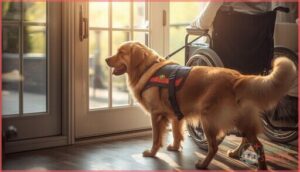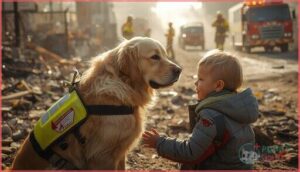This site is supported by our readers. We may earn a commission, at no cost to you, if you purchase through links.
You’d be hard pressed to find a teammate more loyal, focused, and tuned in than an assistance dog at work. Their job goes far beyond the leash, guiding someone through city noise or detecting the subtle shift of a medical episode before anyone else senses it.
With each carefully learned task, these dogs bridge the gap between challenge and possibility, making everyday life safer and a little less complicated for people with disabilities.
Whether they’re nudging an elevator button or easing panic in a crowded room, assistance dogs transform ordinary routines into moments of independence and connection.
Table Of Contents
- Key Takeaways
- What Are Assistance Dogs?
- Types of Assistance Dogs
- How Assistance Dogs Are Trained
- Who Benefits From Assistance Dogs
- Global Impact and Community Initiatives
- Frequently Asked Questions (FAQs)
- What is the difference between a service dog and an emotional support dog?
- How does one obtain a service dog?
- What tasks do service dogs perform?
- How are service dogs trained?
- What are the legal protections for service dogs?
- How do I apply for an assistance dog?
- What ongoing care do assistance dogs need?
- Can assistance dogs travel internationally with their handler?
- How are retired assistance dogs placed or cared for?
- What should you do if you encounter an assistance dog team?
- Conclusion
Key Takeaways
- Assistance dogs are expertly trained to perform specific, disability-related tasks that increase safety and everyday independence for people with various impairments.
- Service dogs are legally protected under the ADA and differ from therapy and emotional support animals, which don’t receive the same rights or task-based training.
- Accredited organizations and owner trainers use positive reinforcement to teach life-changing skills, with trainers and handlers focusing on quality, consistency, and legal requirements.
- Having an assistance dog can greatly reduce the need for outside help, boost independence, and improve quality of life for those living with disabilities.
What Are Assistance Dogs?
Assistance dogs are specially trained working animals that help people with disabilities live more independent lives. They’re not pets—they perform specific tasks their handlers can’t easily do on their own, like guiding someone who’s blind or alerting to a medical emergency.
Understanding what sets them apart from other animals, and knowing the legal protections that come with them, gives you a clearer picture of their important role.
Definition and Purpose
Assistance dogs are specially trained canines that perform disability-related tasks through task-based training, helping with disability mitigation under global standards. Formal assessment and legal recognition define these working partners:
- Guide dogs assist with visual impairments
- Hearing dogs alert to auditory signals
- Service dogs support physical, psychiatric, or neurological disabilities
You’ll find these service animals differ from emotional support animals through their documented task work and disability rights protections. A revised system classifies them by their level of training.
Difference From Therapy and Emotional Support Animals
Understanding these distinctions matters because public perception often blurs the lines between working animals and companions. While service dogs undergo 18-24 months of task-specific training and enjoy full legal access under the ADA, therapy dogs visit groups in supervised settings, and emotional support animals provide comfort without formal task performance or public access rights. As detailed in a Michigan State University Extension article, animals offer health benefits to both people with and without disabilities.
| Animal Type | Training & Task Performance |
|---|---|
| Service Dogs | Extensive disability-specific task training; perform retrieving, alerting, guiding |
| Therapy Dogs | Basic obedience and temperament screening; provide generalized comfort in group settings |
| Emotional Support Animals | No formal training required; offer companionship to one person with mental health needs |
| Legal Access | Service: Full public access / Therapy: Restricted to facilities / ESA: Housing only |
| Mental Health Impact | Service dogs reduce PTSD symptoms 3.7 points more than ESAs; therapy animals boost mood 43% |
Legal Protections and Rights
These distinctions carry real weight in everyday life. Under the ADA, service dogs access all public facilities—stores, restaurants, workplaces—while emotional support animals receive only housing protections.
Yet 86% of assistance dog users faced discrimination in the past year, with access refusals, housing rights violations, and uneven global enforcement still common. ADA penalties reach $150,000 for repeat offenses, yet awareness gaps persist worldwide.
Types of Assistance Dogs
Assistance dogs aren’t a one-size-fits-all solution. Each type is trained for specific tasks that match the unique needs of the person they’ll support.
Here’s a look at the main categories you’ll encounter.
Guide Dogs
If you’re blind or have low vision, a guide dog can become your trusted travel companion. As of late 2023, nearly 19,557 guide dogs were working globally, with 2,894 newly trained by IGDF member organizations in 2024.
- The Seeing Eye, Guiding Eyes for the Blind, and Guide Dog Foundation for the Blind provide fully trained dogs at no cost
- Popular dog breeds include Labrador Retrievers, Golden Retrievers, and German Shepherds
- Training costs average $40,000–$60,000 per dog, covering specialized blindness support skills under IGDF standards
Hearing Dogs
For those managing daily life with hearing loss—one in six adults in the UK alone—hearing dogs become your ears, alerting you to doorbells, alarms, and phone calls. These dogs undergo auditory cue training that meets deaf community support needs.
With hearing loss prevalence expected to double by 2050, proper breed suitability and technology integration are essential to uphold disability rights and accessibility for all users.
Service Dogs for Physical Disabilities
Nearly half of all service dogs support mobility and physical disability needs, enabling you to handle tasks like opening doors, retrieving objects, and stabilizing movement.
Through specialized task training, these assistance dogs work alongside adaptive equipment to reduce your caregiver relief burden while protecting disability rights and accessibility.
They provide real independence gains, helping you navigate daily life with confidence.
Facility Dogs
Unlike dogs that serve individual handlers, facility dogs work alongside professionals in schools, hospitals, and courtrooms to support entire communities.
These animal-assisted therapy programs recorded over 3,200 placements in 2024, with therapy dog training and certification ensuring canine adaptability across diverse settings.
Professional partnerships between handlers and therapy dogs deliver therapeutic benefits while maintaining strict training standards and ethical considerations for animal welfare.
Crisis Response Canines
When disaster strikes, crisis response canines deploy alongside first responders to provide trauma relief and rebuild community resilience. These comfort dog program specialists support psychological impact recovery through animal-assisted interactions during natural disasters, mass casualty events, and school tragedies.
Therapy dog teams deliver emotional support and comfort animals in courtrooms, hospitals, and disaster zones, facilitating healing through animal-assisted support when communities need it most.
How Assistance Dogs Are Trained
Training an assistance dog takes time, expertise, and a real commitment to quality. You’ll find dogs trained through accredited organizations that follow strict industry standards, or you might choose to train your own dog with the right guidance and resources.
Let’s walk through what goes into preparing these amazing working partners for the tasks they’ll perform every day.
Accredited Training Organizations
Assistance Dogs International (ADI) sets the highest standard for service dog training programs worldwide, requiring at least 120 hours of training over six months. ADI accredited member organizations consistently achieve placement rates around 77%, though waitlists average over 7,600 clients.
Here’s what makes these nonprofit organizations stand out:
- No-cost or low-cost placement funded entirely by donors and grants
- Rigorous breeding programs maintained by 60 accredited programs
- Trainer internships offered by 18 member organizations for career development
These programs rely on volunteers—over 26,000 strong—to raise, socialize, and support dogs destined to change lives.
Owner Self-Training Options
You can train your own service dog if professional programs don’t fit your timeline or budget. Training costs range from $2,000 to $7,500—far less than the $30,000+ for program-trained dogs.
The ADA recognizes owner-trained service dogs equally, granting full public access rights. Hybrid programs offer coaching support, and success rates reach 75% with consistent positive reinforcement and disability support focus.
Essential Skills and Tasks
Your dog needs to master real-world tasks you’ll use daily—retrieving dropped items, opening doors, or applying deep pressure therapy during anxiety episodes.
Handlers commonly rely on their dogs 3 to 5 times each day for mobility assistance, problem-solving skills, and independent action.
Positive reinforcement training builds this reliability, with success rates reaching 72% when you focus on task frequency and proper canine training methods that strengthen your partnership.
Standards and Assessment Processes
Behind every skilled assistance dog lies a rigorous evaluation process. ADI accreditation requires at least 120 hours of training over six months, with public access tests measuring your dog’s reliability in shopping centers and transit.
Only 50% of candidates pass these benchmarks, ensuring quality assurance through positive reinforcement training and global standards that protect your rights while upholding service dog training proficiency.
Who Benefits From Assistance Dogs
Assistance dogs serve a wide range of people living with different disabilities and conditions. Each person’s needs determine which type of assistance dog will provide the most meaningful support in daily life.
Let’s look at the main groups who benefit from working with these specially trained partners.
Mobility Impairments
People in wheelchairs, those using walkers, and anyone with balance disorders often rely on assistance dogs for critical daily tasks. Your service dog can help with transfer assistance, item retrieval, and door opening—functions that build real independence.
About 48% of all service dog placements support mobility impairments, and these partnerships generally reduce the need for paid caregiving by 64%.
Autism and Developmental Disabilities
Children with autism often face challenges with safety, communication, and family stress that assistance dogs can help ease. Safety tethering prevents wandering, while these trained companions improve therapy engagement by nearly 9% and strengthen social skills.
Economic support programs are expanding access to this disability support, helping more families reduce anxiety and build independence through specialized service animal training adapted to developmental disabilities.
Seizure and Medical Alert Needs
For those living with epilepsy or diabetes, medical alert dogs offer life-changing disability support through specialized service animal training. These assistance dogs detect seizures or blood sugar shifts with impressive alert accuracy, often sensing changes minutes before they occur.
- Seizure alert dogs reduce monthly seizure frequency by an average of 43% within six months
- Training costs reach up to $40,000, though nonprofits may provide animal assistance at reduced rates
- Legal access protections under the ADA guarantee these service dogs accompany you everywhere
Health outcomes show a 29% decrease in hospitalizations, while demand factors like 2-to-5-year waiting lists reflect their growing importance in disabilities care.
PTSD and Mental Health Support
Veterans and others facing trauma find that psychiatric service dogs can lower PTSD symptom severity by more than 25% within three months. Unlike therapy dogs, these assistance dogs use positive training methods to perform tasks like calming anxiety or interrupting flashbacks.
Handler wellbeing improves through better stress regulation, medication adherence, and social functioning—benefits that animal assistance delivers alongside conventional disabilities care.
Global Impact and Community Initiatives
Assistance dogs touch lives across the world, creating ripple effects that go far beyond any one community. Their presence often brings new opportunities and a stronger sense of independence for those who need it most.
Let’s take a closer look at how their global impact shows up in practice.
Prevalence and Growth Worldwide
Ever noticed how the global dog numbers in assistance programs keep climbing every year? That’s the heartbeat of progress. Regional distribution changes fast thanks to nonprofit organizations, industry growth rate trends, and shifting workforce capacity. Yet, accessibility challenges remain strong, especially for rural teams. It’s the worldwide drive for animal welfare for disabilities that powers true community development in today’s Assistance Dog Industry.
- Rising global placements
- Expanding workforce capacity
- Persistent accessibility challenges
Economic and Social Benefits
Think of an assistance dog as your key to independent living—backed by real healthcare savings, easier days with reduced support needs, and a richer social life.
An assistance dog unlocks greater independence, making life healthier, simpler, and more fulfilling for those who need support
These dogs increase employment rates by helping you navigate work and school, while shifting public perception.
They further the cause of Assistance Dog Rights, boosting accessibility and disability advocacy for truly inclusive community building.
Non-Profit Organizations and Outreach
When you look behind the scenes of every strong community, you’ll find non-profit organizations for disabilities driving change. These groups magnify community impact by:
- expanding volunteer opportunities and community service
- boosting training capacity for future teams
- growing outreach and education programs
- distributing financial support to sustain assistance dog programs
Their reach now spans the globe, shaping disability resources and growing global prevalence.
Advocacy for Accessibility and Rights
Trailblazers in disability rights advocacy know that change begins with raising your voice—loud and clear—about Assistance Dog Rights. With many handlers still facing access denials despite clear accessibility rights, it’s public education and strong legal enforcement that move the needle.
Every advocacy impact adds up, transforming handler experiences and tightening protections across the spectrum of accessibility and disability rights.
Frequently Asked Questions (FAQs)
What is the difference between a service dog and an emotional support dog?
Legal Access marks the divide as wide as the Grand Canyon—service dogs get Federal Protections and rigorous Training Requirements, performing tasks for disabilities, while emotional support and comfort animals mainly offer companionship, facing common Public Misconceptions about their rights.
How does one obtain a service dog?
To get a Service Dog, you start the application process with a nonprofit organization, meeting eligibility criteria related to disability assistance.
Expect training costs, possible wait times, and final placement based on legal rights and Guide Dog Services standards.
What tasks do service dogs perform?
Much like a quiet hand guiding someone through a crowd, service dogs tackle everyday barriers: Mobility assistance, Medical alerts, Sensory support, and Psychiatric tasks—demonstrating the heart of Animal Assistance and Canine Assistance in Disability Assistance.
How are service dogs trained?
Service dog training begins with temperament testing and basic skills, moving into sophisticated skills and generalization training for real-world situations.
Ethical considerations shape all dog training methods, with many trainers favoring force-free approaches despite high training costs.
What are the legal protections for service dogs?
Imagine a key that opens every public door—ADA compliance gives your service dog that right. Handler rights block access denial, mandate accessibility, and enforce fraud penalties, while international laws and advocacy guarantee lasting protection. See the Service Animal Fact Sheet.
How do I apply for an assistance dog?
Start your application by gathering required documentation and references, verifying residency requirements, and demonstrating financial capacity.
Most nonprofit organizations for disabilities require an application fee, wait times up to two years, and a completed Service Animal Fact Sheet.
What ongoing care do assistance dogs need?
Without consistent veterinary checkups, specific dietary needs, and a daily exercise regimen, animal welfare can slip quickly.
Grooming standards, mental health care, and rehabilitation and support services all shape every stage of animal training and canine training.
Can assistance dogs travel internationally with their handler?
Yes, assistance dogs can travel internationally with you, but each country and airline has its own regulations, breed restrictions, and documentation requirements.
Quarantine rules and destination policies for animal assistance teams take careful planning and advocacy.
How are retired assistance dogs placed or cared for?
Retired assistance dogs most often remain with their original handlers, easing the financial burden and emotional adjustment.
Agency policies may support placement options, monitor welfare, and offer resources.
Retirement age and ongoing care shape animal welfare and advocacy efforts.
What should you do if you encounter an assistance dog team?
Imagine this: you see someone relying on a focused teammate for independence.
Give them space—avoid talking, touching, or staring at the service dog. Respectful interaction preserves handler privacy, ensures public etiquette, and bolsters training awareness for assistance animal teams.
Conclusion
To find comfort, trust, and greater freedom—these are the gifts an assistance dog can bring. With training rooted in respect, adapted to the smallest needs and the largest hopes, each partnership turns adversity into advantage.
If you’re weighing the way forward, remember: assistance dogs aren’t just service animals. They’re bridges to possibilities, guides through uncertainty, and steady companions for every mile ahead. The partnership doesn’t just change routines—it changes lives.
- https://www.dogster.com/statistics/service-dog-statistics
- https://www.sciencedirect.com/science/article/pii/S0149763425001605
- https://esapet.com/emotional-support-animal-statistics/
- https://pmc.ncbi.nlm.nih.gov/articles/PMC11922260/
- https://www.dogbase.co/blog/service-dog-training-breakdown-how-long-and-whats-involved















